The BEST episodes of The Future is Wild season 1
Every episode of The Future is Wild season 1, ranked from best to worst by thousands of votes from fans of the show. The best episodes of The Future is Wild season 1!
With the help of scientific experts and advanced computer programs, this Discovery Channel series is able to take a look at what the future would be like millions of years ago, after millennia of evolution phase humans completely out of existence. A bleak idea at first, these educated hypotheticals soon prove to be truly outrageous and often amazing - after all, what human could compete with eight-ton squids roaming around on dry land, or spiders big enough to eat mammals for breakfast?
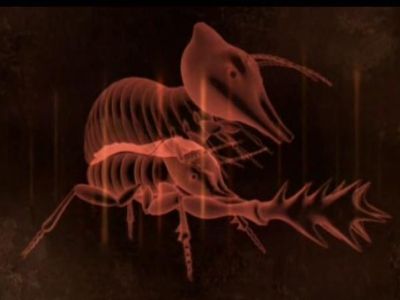
#1 - The Endless Desert
Season 1 - Episode 10 - Aired 6/4/2002
The Endless Desert is set in the central desert of the new Pangea, 200,000,000 years into the future. At this point in the future, there are no mammals, birds, reptiles or amphibians. The episode focusses on four species. Terrabyte - descendants of termites that live in massive air-conditioned underground cities where they farm algae. Each termite is built for a specific role. There are transporters, glue-spitters, diggers and other types too, which form a caste system. Gloomworm - a simple worm that is descended from a single type of bristleworm which survived the mass extinction. Slickribbon - a transparent creature with pincer jaws and a nasty sting. It appears to be descended from the same bristleworm as the Gloomworm. Garden Worm - another descendant of the bristleworm, the garden worm houses green algae in fleshy lobes that stick out like leaves from their backs. The algae convert sunlight into food to feed their host. With no rainfall reaching the middle of the single continent, the whole place has dried up. Patches of water are rare and in demand. Many of the animals here live in underground lakes and caves to get away from the heat of the desert.
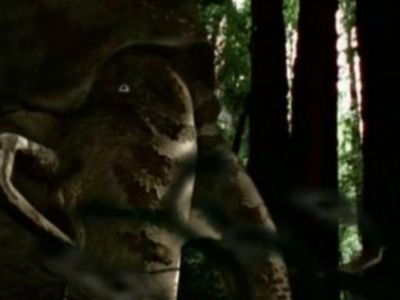
#2 - The Tentacled Forest
Season 1 - Episode 13 - Aired 6/25/2002
The Tentacled Forest is set in the northern jungle, 200,000,000 years into the future. At this point in the future, there are no mammals, birds, reptiles or amphibians. The episode focuses on three species. Forest Flish - a smaller species of flish with hooks for feet so it can hang upside down to rest Megasquid - a four metre tall squid with rhino-like skin and three metre tentacles which patrols the forest. Its eight boneless legs are packed with muscles that act like bones. Squibbon - an arboreal species of squid with stereoscopic vision that could well be the next sapient life on the planet This forest is about the only place left on Earth where there is consistent rain and trees can grow. The trees here are lichen trees, descended from simple lichens. The forest is populated with a whole manner of creatures that would look out of place in our time. The episode shows how animals that were once aquatic have evolved to conquer the forests. It also suggests that the squibbon could become the next species to develop sapience and become the dominant force on planet Earth.
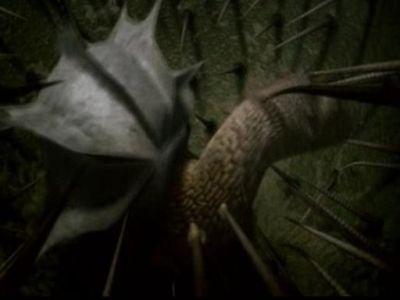
#3 - Graveyard Desert
Season 1 - Episode 12 - Aired 6/18/2002
Graveyard Desert is set in a rainshadow desert on the eastern side of Earth's only continent, 200,000,000 years into the future. Wedged between this desert and the Global Ocean is a series of very tall mountain ranges (which are comparable to the Andes in today's world) which are tall enough to block even the most powerful storms. At this point in the future, there are no mammals, birds, reptiles or amphibians. The episode focuses on two species. Bumblebeetle - a species of insect that has been pushed to the edge of specialisation. They spend their lives searching for dead flish which are a good food source. Desert Hopper - a rabbit-sized snail that hops about on one muscular foot. They tend to bury themselves during the heat of the day and only come out at night. The episode also features Ocean Flish but these are not discussed in detail. (See the previous episode for details on this species). The desert has little food so the animals here must make use of what they can. During violent ocean storms, some ocean flish are thrown over the mountains and land in the desert where they die. Bumblebeetles spend their entire lives searching for these dead ocean flish so they can lay their young in them.
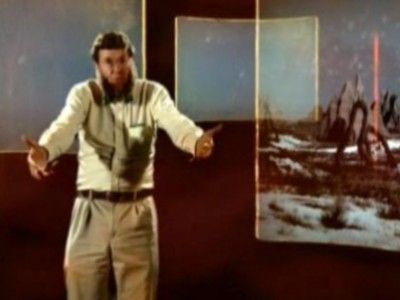
#4 - The Great Plateau
Season 1 - Episode 9 - Aired 5/28/2002
The Great Plateau is the ninth episode in the documentary series The Future Is Wild. It is set in a lofty plateau created by the collision of Australia (who moved northward) against Japan and Kamchatka (the Asian tectonic plate), 100,000,000 years into the future. The episode focuses on three species. Silver Spider - a descendant of our spiders, the silver spiders live in huge colonies and have a caste system based on the size of the animal. They build massive webs across canyons. The queens can grow to the size of footballs. Poggle - the last species of mammal on Earth at this time. It is prey to silver spiders and looks much like a hamster. Great Blue Windrunner - a brilliant blue bird with wings on its legs which sees in ultraviolet and lives at the highest points on the plateau. This episode shows how this bizarre food chain works. The silver spiders build massive webs across canyons which catch seeds from grass trees. These are then harvested by the spiders and taken to an underground cavern. In here, the poggle hides and feeds on the seeds until they are killed and fed to the enormous queen. Great blue windrunners feed on the spiders that they pluck from the webs. At the end of the episode, we see the beginning of a mass extinction, which almost wipes the slate clean and allows evolution to start again.
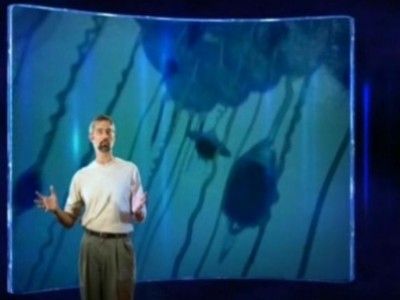
#5 - Flooded World
Season 1 - Episode 7 - Aired 5/14/2002
Flooded World is set in shallow seas of the world, 100,000,000 years into the future. The episode focusses on three species which all live together. Ocean Phantom - a type of Siphonophora that can grow to ten metres in diameter. Reef Glider - a descendant of the sea slug which hunts ocean phantoms. The young, however, are prey to the ocean phantom. Spindle Trooper - spider-like creatures that live in chambers on the ocean phantom and protect it from danger. The ocean phantom in return feeds it. This episode focusses on the extinction of the coral reefs and their replacement with red algae reefs. It shows how this food chain works and how the animals have evolved together. It also shows how ocean phantoms can be ripped apart by a severe storm but still carry on living.
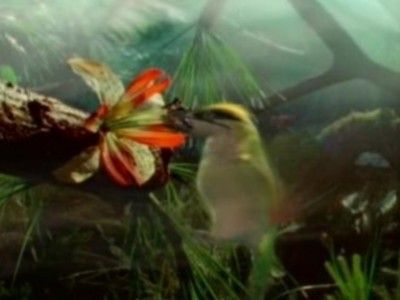
#6 - Tropical Antarctica
Season 1 - Episode 8 - Aired 5/21/2002
Tropical Antarctica is set in Antarctica, 100,000,000 years into the future. The episode focuses on five species. Roachcutter - a descendant of an undisclosed sea bird and one of the first species to colonise Antarctica. It feeds on the insects of the forest and flies incredibly fast and with brilliant agility. Spitfire Bird - a descendant of an undisclosed sea bird which collects chemicals from flowers of the Beech Burner which it then spits at enemies. Falconfly - a descendant of the wasp which feeds on birds Spitfire Beetle - a beetle that gathers in groups of four to take on the appearance of a Beech Burner flower. They then pounce when a spitfire bird gets close. False Spitfire Bird - a bird that looks almost identical to the spitfire bird but cannot fire chemicals. At this point in the future, Antarctica has moved so far north it is now on the equator and has grown a jungle. It shows how the seabirds have evolved to deal with the new dangers of the jungle. Oxygen levels have also allowed insects to grow big again.
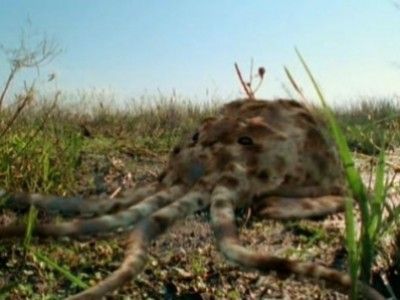
#7 - Waterland
Season 1 - Episode 6 - Aired 5/7/2002
Waterland is set in the Bay of Bengal, 100,000,000 years into the future. The episode focusses on three species. Toraton - a descendant of the tortoise and the largest creature ever to walk the Earth. They can weigh up to 120 tonnes. Swampus - a descendant of the octopus which has become amphibious and formed a symbiotic relationship with a plant to house its young. They are very intelligent. Lurkfish - a fish that can fire up to 1000 volts to stun prey. They are fish and ambush predators. The episode shows that at this point of the future, volcanoes are belching out copious amounts of greenhouse gases causing the planet to overheat. It shows how swampus breed and how toraton have evolved to cope with their new size.
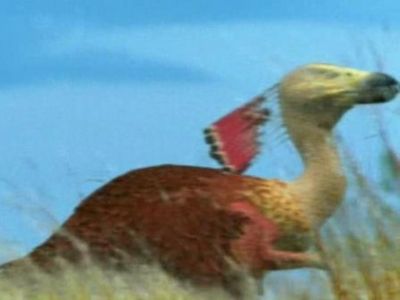
#8 - Prairies of Amazonia
Season 1 - Episode 4 - Aired 4/23/2002
Prairies of Amazonia is set in South America where the Amazon used to stand in 5,000,000 years time. It features three species:- Carakiller - a descendant of the caracara which has evolved to replace land predators. Babookari - a descendant of the uakari which lives like baboons and has discovered how to catch fish. Rattleback - a descendant of the agouti or paca which has developed tough armour and can live through quickly-passing grass fires. This episode shows that due to the cooling of the planet, the Amazon rainforest has vanished and has been replaced by grassland. Most primates have died out but the Babookari has evolved to live on the plains. They have also become much cleverer and can now make nets out of twigs to catch fish. There is also the Rattleback, a heavily defended rodent which is somewhat fireproof and birdproof and lives on a diet of Carakiller eggs.
#9 - Welcome to the Future
Season 1 - Episode 1 - Aired 4/2/2002
Welcome to the Future is the first episode in the documentary series The Future Is Wild. It shows what is to be featured in the coming episodes. It opens by discussing which animals (such as the big cats and bears) will disappear in a few thousand years and explains that evolution will continue. It is also the only episode to touch upon the absence of humans in the future. It does not, however, explain what happened to the human race. The creators said that it was up to the viewers to make their own assumptions about the fate of mankind. .
Watch Now:Amazon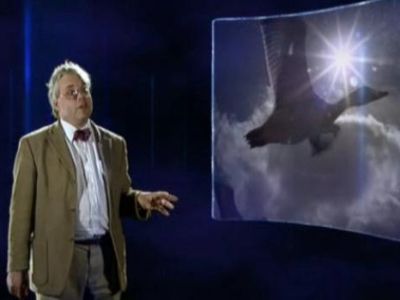
#10 - The Global Ocean
Season 1 - Episode 11 - Aired 6/11/2002
The Global Ocean is set in the only ocean in the world, 200,000,000 years into the future. At this point in the future, there are no mammals, birds, reptiles or amphibians. The episode focusses on four species. Rainbow Squid - although some cephalopods took to the land, this one did not. It is a massive squid which changes colour to hide. Ocean Flish - descendants of common fish like cod which have evolved to breathe out of water and have developed wings. Sharkopath - a descendant of sharks that have bio-luminescent patches on their sides to communicate with one another. Silverswimmer - descendants of plankton that have grown in size and evolved to fill the roles that fish previously held. There are many different species and they have different ways of life - some are predators, some are prey and some are scavengers. Since all the land is joined together, much like Pangea, there is only one ocean now as well. Some views from space show the Earth as just a blue circle now. This episode shows how weird things have got and, no matter what happens, life will continue to thrive in the oceans
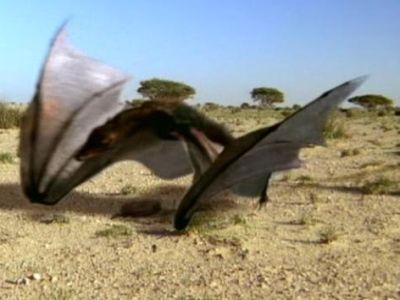
#11 - Cold Kansas Desert
Season 1 - Episode 5 - Aired 4/30/2002
Cold Kansas Desert is set in North America, 5,000,000 years into the future. The episode focusses on three species:- Deathgleaner - a massive carnivorous bat that spends the day hunting for prey in the desert and spends the night in a communal roost. Spink - a descendant of the quail whose wings have become digging paddles. The species lives much like the naked mole rat of our time. Desert Rattleback - a descendant of the agouti and a relative of the rattleback from the previous episode. This one is better suited for cold regions. The episode explains that the onset of the ice age caused the agricultural belt of the USA to turn into a desert where temperatures at night regularly reach freezing. The episode shows how the animals have evolved to cope with the harsh features of this forbidding landscape.
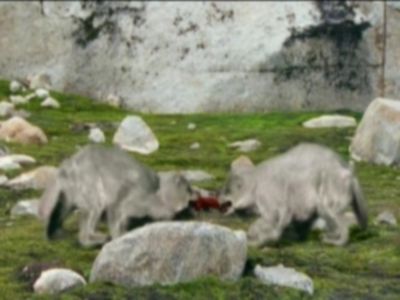
#12 - Return of the Ice
Season 1 - Episode 2 - Aired 4/9/2002
Return of the Ice is set in Europe, 5,000,000 years into the future. The episode focuses on three species:- Shagrat - a descendant of the marmot that has grown in size and developed thicker fur to protect it from the cold. Snowstalker - a descendant of the wolverine that has evolved sabre-teeth and white fur for camouflage. Gannetwhale - a descendant of the gannet which has grown to immense size to replace the sea mammals. The episode follows the story of a female Snowstalker teaching her cubs to hunt, the Gannetwhale's breeding season and the mass migration to the south of the Shagrats.
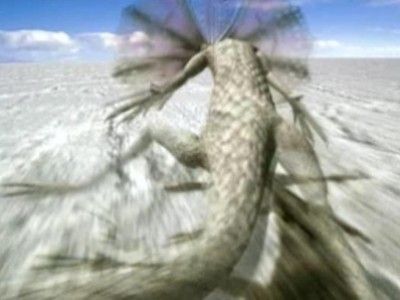
#13 - The Vanished Sea
Season 1 - Episode 3 - Aired 4/16/2002
The Vanished Sea is set in what was the Mediterranean sea in 5,000,000 years time. It features four species:- Cryptile - a descendant of the salt desert lizard with a sticky frill to catch flies which it can then lick off at its leisure. Scrofa - a descendant of the wild boar which has developed spindly legs to allow it to live on the rocky islands in the desert. Gryken - a descendant of the pine marten which hunts Scrofa in the cracked rocks of the landscape. Brine flies - these don't appear to have evolved too much but are the only animals around capable of drinking the salty water. Before this time in the future, the tip of Africa has collided with the southern tip of Spain, thus enclosing the Mediterranean inland. It has since dried up to become an enormous salt desert with a few lakes of ultra-saline water, as it was during the Messinian salinity crisis. The holiday islands that used to be in the sea are now mountains scattered throughout the desert.